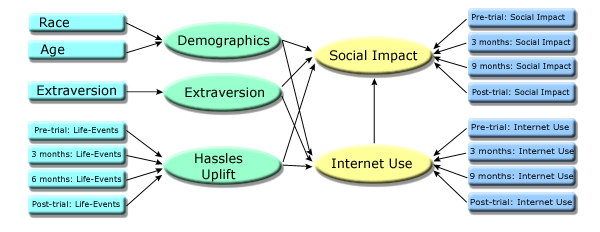
Research has produced conflicting findings about the social impact of home Internet use. Some studies find that Internet use has a positive impact, increasing social involvement and psychological well-being, while others suggest a negative impact (i.e., less social involvement and greater depression with greater Internet use). One purpose of the HomeNetToo project was to examine the social impact of Internet use in a sample of low-income, novice Internet users. Findings indicate that Internet use had no effect on social involvement and psychological well-being when demographic and personality characteristics, and daily life events that influence social involvement and psychological well-being were taken into account.
Internet use; psychological well-being; social involvement; Internet paradox.
In 1998, researchers at Carnegie Melon University (CMU) reported evidence of what they labeled "the Internet paradox" [1]; greater Internet use was associated with less psychological well-being (e.g., greater depression and loneliness) and less social involvement (e.g., less time spent with family and friends). These findings were considered paradoxical because the Internet is generally assumed to facilitate social connectedness and therefore the psychological and social benefits associated with it, and because the primary use of the Internet by CMU HomeNet participants was to communicate with others (i.e., e-mail). Indeed, so surprising were the original HomeNet study findings that articles appeared in the NY Times proclaiming a "Sad, lonely world discovered in cyberspace" (August 30, 1998), and in USA Today proclaiming "Heavy Net use cuts into real life." (February 16, 2000), among others (e.g., "A Web of workaholic misfits? Study finds heavy Internet users are socially isolated." The Washington Post, February 16, 2000). However, results of the 3-year follow-up study by CMU researchers indicated that most of the negative psychological and social effects of Internet use disappeared after 1.5 years, with two exceptions; Internet use remained associated with greater stress and, for introverts, with greater loneliness and depression [2]. Other research examining the social impact of Internet use has produced mixed results, with some studies finding a positive impact and others finding a negative impact [3][4].
The HomeNetToo project was based in part on the CMU HomeNet study. Internet use was automatically logged and measures of social involvement and psychological well-being were obtained at multiple points. One important difference, however, was that our sample was chosen to examine the social impact of Internet use on the "other side of the digital divide" in the U.S. Thus, our participants all had low incomes by U.S. standards.
Participants in the HomeNetToo project were 117 adults; 67% African American,
80% female, and 42% never married. Almost half (49%) had family incomes of less
than $15,000 USD annually. Average age was 38.6 years old. Sample demographics
reflect those of low-income adults in this geographic area (i.e., mid-western
U.S, mid-size urban community).
Four automatically server-logged measures of Internet use are considered in
this report: time online (minutes/day), number of Internet sessions (log-ins/day),
number of unique Web domains visited (per day), and number of e-mails sent (per
day). Surveys completed at pre-trial, three months, nine months, and post-trial
(15 months) contained multiple measures of social involvement (10 measures,
e.g., # of friends) and psychological well-being (6 measures, e.g., depression).
Structural equations modeling was used to examine whether Internet use predicted social involvement and psychological well-being after controlling for other factors (e.g., race, age, extraversion). The overall conceptual model is presented in Figure 1. Regardless of measure, Internet use had no influence on social involvement or psychological well-being. Rather, extraversion, daily hassles, daily uplifts and, to a lesser extent, demographic characteristics predicted these outcomes. Extraverted participants and those who had fewer daily hassles were less depressed than introverted and more hassled participants, respectively. Participants who experienced more uplifts were happier than those who experienced fewer uplifts.
Other findings indicated that, on average, participants used the Internet 43 minutes per day, participating in 1 session and visiting 10 domains. However, they sent only 3 e-mails per week. African Americans and older participants (38 years old and above) used the Internet less than did European Americans and younger participants, respectively, but only during the first year. African Americans were less depressed, less stressed and more socially involved than were European Americans. Older participants were happier than younger ones.
Findings from the HomeNetToo project indicate that home Internet use had no effect on the social involvement or psychological well-being of low-income adult users. These findings were robust with respect to how social involvement, psychological well-being, and Internet use were measured.
Explanations for the discrepancy between our findings and those of the CMU HomeNet project may lie in differences in how the Internet was used by our participants. Although they used it as frequently as the "average" Internet user [5], they used e-mail much less than the average user. In hindsight this is unsurprising. Our low-income participants were less likely than higher-income participants to have family and friends online, or to have jobs that required online communication. Interview data indicated that they seldom used the Internet to communicate with strangers. Thus, the social impact of Internet use may depend on the extent to which communication tools rather than information tools are used.
Another explanation for the absence of Internet use effects on social involvement and psychological well-being may lie in changes in the Internet since the original HomeNet study in 1995. As CMU researchers point out, the increasing number of Internet services designed to please, entertain or otherwise capture the users' attention may explain why today's Internet is less likely to have a negative social impact than the Internet of old (circa 1995).

This research was supported by a grant from the National Science Foundation, Information Technology Research, #085348, HomeNetToo: Motivational, affective and cognitive factors and Internet use: Explaining the digital divide and the Internet paradox. Linda A. Jackson, Principal Investigator. Project Period: September 1, 2000 to August 31, 2003. Additional authors are Gretchen Barbatsis, Yong Zhao, and Hiram Fitzgerald, all of Michigan State University.